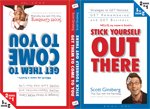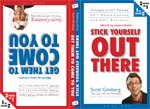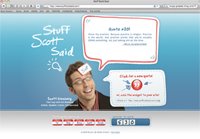 I don’t edit.
I don’t edit.
I don’t rewrite.
I don’t do drafts.
I don’t go back and revisit old work.
I write things once, I write them in blood, and I publish them to the world with zero regret and infinite confidence.
Sure, I might change a few words here and there. Or modify my position on an issue. And of course, always make grammatical improvements at the request of my (awesome) editor.
But that’s proofreading.
Editing means correcting the core of something.
And the moment you allow that to happen – to the work or to the person who authors it – is the moment you betray yourself.
Self-editing renders your creativity timid and impotent, and it’s not fair to your core to let that happen.
THE COOL PART IS: Living a life without editing yourself isn’t just about writing.
It’s about walking your truth.
It’s about breathing your brand.
It’s about staying loyal to yourself.
It’s about giving your river a voice and letting it flow.
Ready to put away your red pen? Let’s explore strategies to slay your inner editor and let your truth sing:1. Live without interference to the expression of your own individuality. Refusing to self-edit means you’re determined to stay undeterred when people attack you for exercising your ability.
This will probably happen more than once. Especially from the mouths of the mediocre. And it’s essential that you proactively pursue your own path despite lack of popular appreciation and understanding.
The hard part is, when the hurricane of Haterade devastates your inner landscape, it leaves a lot of soul damage. After all, your work isn’t close to your heart – it is your heart.
If you’re like me, you have this deep-rooted tendency to express your total sense of life. To embrace the totality of your truth, knowing that everything you do is an extension of the world you came from.
My suggestion: Don’t just stay the course – stay your course. Otherwise you destroy yourself in response to an invitation from others to stop living. Where are you holding back from expressing yourself?
2. Keep brighter company. Find people who won’t try to change you. Ignore people who attempt to smother you with their bodyguard of dogma. Delete people whose life goal is to stamp out any shred of creativity. And avoid people who seek to systematically beat the originality out of you.
Individuals like these are cul-de-sacs of deadening cumulative saturation. And unless you surround yourself with people who challenge, inspire and support you, their negative voices will blend with your own. You’ll subconsciously absorb their whispered suggestions. And the red pen of self-editing will run out of ink very quickly.
As graphic novelist Alan Moore said, “When we’re doing the will of our true self we are inevitably doing the will of the universe and it’s impossible to do anything wrong.” Whose voices are blending with your own that cause you edit yourself?
3. Endure the scrutiny of spectators. “Scott, not everyone will get you. Learn to be cool with that.” My mentor told me that a few years ago. And it reminded me that you’re nobody until somebody hates you.
After all, if everybody loves your brand, you’re doing something wrong.
Then again, that’s just part of the success equation. And it’s shocking because you figure everybody would be happy for your success. But they’re not. Outside of those who really, really love you – your success will piss most people off. And it will drum up significant resentment, even if it’s never vocalized.
My suggestion is: Don’t get mad at people for being mad at you. It’s their perfect right. Just tell them, “I respect your opinion of my work,” and get on with your life. Otherwise their envy will encourage you to edit yourself.
Remember: If people don’t like you, why would you assume they have good taste?
Clearly, they’re morons. Otherwise they’d recognize your awesomeness a lot sooner. When the slings and arrows of outrageous fortune head your way, will you hold up your shield calmly or head in the other directly cowardly?
4. Accept not the status quo of the thinking that surrounds you. Don’t walk somebody else’s path. Don’t resign to reaching a certain familiar melody. And don’t allow the world to superimpose onto you its prefabricated definition of who you should be.
Otherwise, what you need to practice gets lost in what you are told to believe. The question is:
How do you drown out the toxic chorus of voices calling you to edit yourself?
Easy: Stop allowing the world to choose for you. It’s anesthesia of the heart. Don’t be bound and limited by the thoughts others have formulated for you. Instead, believe that you are the shaper of you.
Ask permission from your heart and nothing else. Be brave enough to inquire within. Trust yourself. Walk in a receptive and expectant state of mind. And you will remove what blocks the path of truth.
Ultimately, you’ll sustain more honesty per square inch than anyone you know. And you’ll reach a level of intimacy with yourself where you won’t need to write more than one draft. Ever. Remember: When you look outside of yourself, all you find are more questions. Whose permission do you seek?
5. Don’t save your opinion for later. Especially in those moments when you get the squirms. Find some means of saying the essential thing that is within you and let your art find its own legs.
The key is to remain respectful in your response. I learned this from my friend Nico during a workshop with a group of Toronto sanitation workers. She offered a suggestion that stopped the collective heartbeat of the entire audience:
“Listen to who you are before responding.”
Great idea. Especially since each of us has our own personal and emotional response to existence. Without that, without listening to who you are first, you’re just a parrot. A ditto. A copy machine.
As novelist and philosopher Ayn Rand once said, “If you, as an independent thinker, are trying to move the world – you cannot shrug”
She’s right. If you’re going to do your own thinking, you’ve got to give up what you’ve been taught to believe, impose your own order on chaos and slash your canvas to pieces. What do you need to let out before Friday?
6. Make no restrictions on your testimony. The question I constantly ask myself while writing is, “What do I risk in presenting this material?” If the answer is, “not much,” I don’t write it.
But.
If the material scares me, I write it.
If the material stretches me, I write it.
If the material makes me hesitate even a millimeter, I write it.
If the material convinces me that some Podunk housewife in Texas is going read one particular sentence of my blog – and think to herself, “Dude, this guy is disturbed!” – then I’d definitely going to write it.
That’s how you slay your inner editor: By redirecting your fear into a more creative channel. The challenge is learning how to assess the risk level of the ideas you share with the world.
Try this: Create a personal security system. Some form of biofeedback to alert you that your work has entered dangerous, honest and unedited territory.
*A hesitation in your hand?
*Do you notice a pulse in your gut?
*An increase in perspiration down your back?
Good. Now you know – based on bodily wisdom – that you’re crafting material that’s real and true. Which means you don’t have to edit. Because you’re living the best, highest version of yourself. What system can you put in place to remove the restriction of your expression?
7. Stand your ground without stepping on people’s toes. I should note that’s there is one caveat to living life without editing yourself: Terminal uniqueness. It’s defined as “thinking you’re uniquely qualified, excessively entitled or appointed to behave a certain way at the expense of others.”
Not attractive. And people can smell it from a mile away. The challenge is balancing between self-editing and self-righteousness. Because while you don’t want to wear yourself out trying to be something you’re not, you also don’t want to wear others out by trying to be on all the time.
Otherwise you wind up sticking to your guns only to shoot people in the foot. Including yourself.
Just be careful. Have some tact. You don’t need to share your opinion on every issue with every person on every occasion. Silence isn’t self-editing – it’s just self-etiquette.
Make sure you don’t become a victim of your own conviction. Otherwise commitment without cordiality becomes contamination. Is your commitment to slay you inner editor causing collateral damage?
8. Stock is the enemy of stardom. In his book Act of Creation, Arthur Kohler suggested that the measure of an artist’s originality is the extent to which his selective emphasis deviates from the conventional norm.
Case and point: There are no cover bands in the Rock and Roll Hall of Fame. But this isn’t just conjecture – I’ve actually been there several times. And every time I go, I’m reminded of one fact:
The musicians who were inducted were the ones who refused to edit themselves.
From Springsteen to Jagger to Lennon to Gilmour, these people gave their music a singular quality. And the world followed whatever came out of them.
That’s the lesson for musicians and non-musicians alike: Every worthwhile life has a theme song.
If there’s something inside you, it’s your duty to sing your story. In a recent blog post, entrepreneur Seth Godin democratized it beautifully:
“The people who successfully start independent businesses do it because we have no real choice in the matter. The voice in our heads won’t shut up until we discover if we’re right, if we can do it, if we can make something happen. This is an art, our art, and to leave it bottled up is a crime.”
Just follow whatever comes out of you. Grab it with both hands. Crack the egg open and let the light come shining in. And never underestimate the power of a liberated artistic mind. Who’s doing a tribute to your music?
9. Trust most the art that executes quickly. Few things in life are more exhilarating than getting on a roll with your work. To the point where you lose track of time, shut yourself off from all external noise and, in my case, spill a mug of green tea down your pants without even noticing it until the dog wanders into the room three hours later and starts licking your thigh.
But, that’s the good stuff. That’s when you’re wired into the hard drive of the creative unconscious. And as such, one of my mantras has become, “Quiet. The art is coming.”
If you truly want to slay your inner editor, you have to learn when to shut up and take down notes. That’s all creativity is anyway: Active listening. You don’t decide what you’re going to write – you listen for what wants to be written.
What sucks is, the voice of your self-editor can get pretty noisy. Your challenge is to listen to the voice that comes quickest – not loudest. Do that and you’ll bleed your truth all over the page.
Remember: Most of this stuff operates below the threshold of awareness, engineered by the unconscious. So, while you don’t need to know where you’re going – you do need to go there with everything that you are. Are you ready to receive the gift of yourself?
REMEMBER: Self-editing is self-betrayal.
Look: I know what you’re thinking:
Sometimes it’s safer to sabotage the work.
Sometimes it’s safer to sabotage yourself.
And you’re right – it is safer.
But to those who seek to turn their lives into remarkable portraits of brilliant creative expression, safe is a very dangerous place to be.
Stop editing yourself.
Your heart can’t take it anymore.
LET ME ASK YA THIS…
What is preventing your truth from singing?
LET ME SUGGEST THIS…
For the list called, “11 Ways to Out Market Your Competitors,” send an email to me, and you win the list for free!
* * * *
Scott Ginsberg
That Guy with the Nametag
Author, Speaker, Entrepreneur, Mentor
[email protected]
 The world’s FIRST two-in-one, flip-flop book!
The world’s FIRST two-in-one, flip-flop book!
Buy Scott’s comprehensive marketing guidebook on Amazon.com and learn how to GET noticed, GET remembered and GET business!


 Average inhibits your ability to grow.
Average inhibits your ability to grow. My favorite episode of Mad Men is called “Lipsticks & Dipsticks.”
My favorite episode of Mad Men is called “Lipsticks & Dipsticks.”  That’s nice, but… We’re not Apple.
That’s nice, but… We’re not Apple. A few weeks ago we talked about
A few weeks ago we talked about  The world’s FIRST two-in-one, flip-flop book!
The world’s FIRST two-in-one, flip-flop book! Stick-to-itiveness can be learned.
Stick-to-itiveness can be learned. Who’s quoting YOU?
Who’s quoting YOU? I don’t edit.
I don’t edit. The world’s FIRST two-in-one, flip-flop book!
The world’s FIRST two-in-one, flip-flop book! Contrary to popular practice, it’s not smart to have dumb customers.
Contrary to popular practice, it’s not smart to have dumb customers.